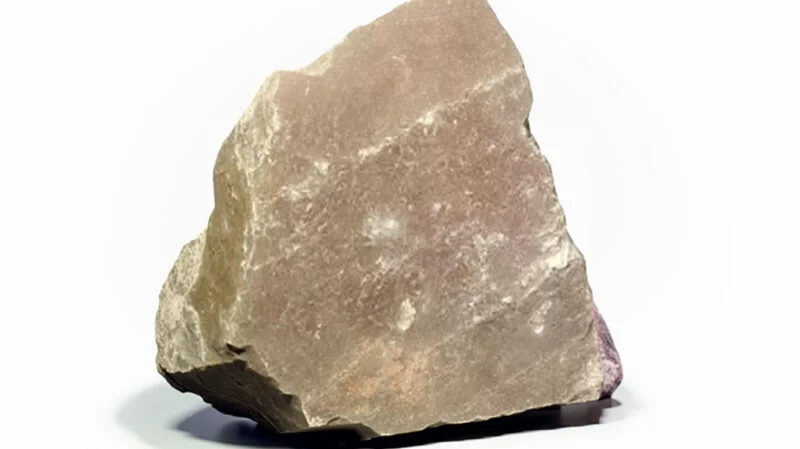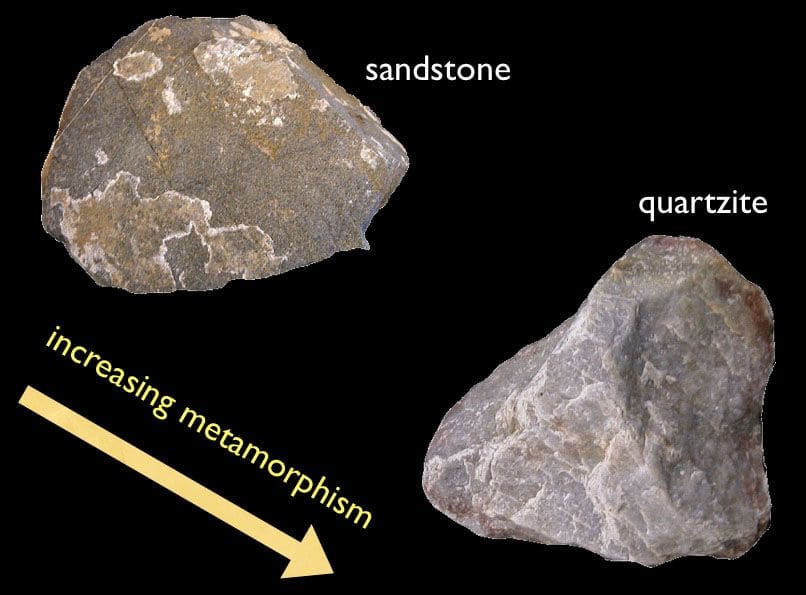
As the name implies, quartzite is a rock rich in the mineral quartz. In this article, we delve into the nature of quartzite, what makes it special, and how to identify it.
What is Quartzite?
Quartzite is a hard, non-foliated metamorphic rock, originally pure quartz sandstone. Its transformation occurs through significant heating and pressure, typically associated with tectonic compression in orogenic belts. This rock is renowned for its durability and strength, making it a standout among other types of rock.
Formation and Composition of Quartzite

Quartzite begins as sandstone, a sedimentary rock composed predominantly of sand-sized quartz particles. Sandstone transforms into quartzite deep within the Earth’s crust, typically in regions known as orogenic belts. These are zones of intense pressure and heat due to tectonic activities like mountain-forming processes.
The sandstone is subjected to temperatures and pressures that are significantly higher than those at which it formed. As a result, the quartz grains within the sandstone begin to dissolve and recrystallize under these extreme conditions.
Quartzite’s defining component is silicon dioxide (SiO2). In its purest form, the rock is almost entirely composed of quartz. However, it is common for quartzite to contain varying amounts of other minerals and impurities. These additional components are often responsible for the rock’s varied color palette. Iron oxide can impart shades of red or pink, while other minerals may contribute yellows, greens, blues, and oranges.
In certain instances, some quartzites can reach purity levels of about 99% SiO2. This type of rock is known as orthoquartzite. This highly pure form of quartzite is distinguished by its minimal inclusion of other minerals.
Characteristics of Quartzite
Quartzite has a suite of distinctive features that reflect its origin and composition.
Hardness and Durability
One of the most notable characteristics of quartzite is its exceptional hardness. On the Mohs scale of mineral hardness, quartzite typically ranks at a 7, which is comparable to that of its primary component, quartz. This high hardness makes it resistant to abrasion and suitable for various applications where durability is crucial.
Fracture and Texture
Quartzite exhibits a conchoidal fracture, similar to glass and obsidian. This means it tends to break along curved surfaces, giving it a smooth and sometimes glassy appearance. The texture of quartzite is another defining trait. While it has a grainy, sandpaper-like feel to it, the surface of quartzite can be polished to achieve a high sheen, showcasing its crystalline nature.
Color Variations
While pure quartzite is typically white or light gray, the presence of various impurities can give it a wide range of colors. Iron oxide imparts hues of pink or red, while other minerals can create shades of yellow, blue, green, and orange. These color variations add to the aesthetic appeal of quartzite, making it a popular choice for decorative purposes.
Grain Structure
Under magnification, quartzite reveals its true metamorphic nature. The rock consists of an interlocking mosaic of quartz crystals. This granoblastic texture is indicative of the intense recrystallization process the rock has undergone, transforming the original sandstone’s loose grains into a tight, crystalline matrix. This granoblastic texture is characterized by an equigranular, medium to coarse-grained structure, where the mineral grains are roughly equal in size and shape. Granoblastic textures are typically formed under conditions of high temperature and moderate pressure, where recrystallization results in the growth of interlocking grains with straight or slightly curved boundaries.
Resistance to Weathering
Quartzite’s composition and structure make it highly resistant to chemical and physical weathering. Its near-pure silica content means it has a low reactivity to acids and environmental pollutants. This resilience makes quartzite a prominent feature in rugged, exposed landscapes, such as mountain ridges and escarpments.
Heat and Chemical Resistance
The high silica content also imparts a significant resistance to heat and chemicals. Quartzite does not easily conduct heat and is resistant to high temperatures, which makes it suitable for various industrial applications. Additionally, its low chemical reactivity means it does not easily alter or decompose when exposed to different substances.
Occurrence of Quartzite
Globally, quartzite is prevalent in areas characterized by folded mountain ranges. These ranges are typically formed at convergent plate boundaries, where the intense tectonic compression facilitates the metamorphism of sandstone into quartzite.
- In the United States, notable formations of quartzite can be found in eastern South Dakota, southwestern Minnesota, the Wasatch Range in Utah, the Baraboo Range in Wisconsin, Central Texas, and near the Washington, D.C. area. Regions in Pennsylvania and parts of Arizona and California also feature significant quartzite deposits. The town of Quartzite in Arizona, for example, is named after the abundant quartzite found in the nearby mountains.
- In Canada, the La Cloche Mountains in Ontario are primarily composed of white quartzite. In addition, vast areas of Nova Scotia are underlain by this durable rock.
- In the United Kingdom, quartzite outcrops include the craggy ridge of Stiperstones in Shropshire and Cambrian-aged formations like the Wrekin quartzite and Hartshill quartzite.
- In Europe, quartzite deposits are found in the Rhenish Massif and the German Central Highlands, extending into the Western Czech Republic. In Poland, notable deposits are present in the Świętokrzyskie Mountains.
- In Norway, large quarries near Austertana and Sandhornøy are significant sources of quartzite.
How to Identify Quartzite
This guide will walk you through the key characteristics to look for when trying to determine if a rock is a quartzite.
1. Examine the Hardness
- Use the Mohs Hardness Test: Quartzite has a hardness of about 7 on the Mohs scale. To test this, see if the rock can scratch glass (which has a Mohs hardness of about 5.5) or if it can be scratched by a steel file (hardness around 6.5).
- Note the Feel: Quartzite typically feels harder than most rocks you might encounter.
2. Observe the Texture and Appearance
- Look for a Grainy Surface: Quartzite often has a sandpaper-like texture, which is a remnant of its sandstone origins.
- Check for a Glassy Luster: On freshly broken or cut surfaces, quartzite may have a glassy sheen.
3. Study the Color
- Identify the Color Variations: Pure quartzite is usually white or gray, but it can also occur in shades of pink, red, yellow, blue, green, and orange due to impurities.
- Watch for Consistency: The color in quartzite is typically more uniform than in other rocks like granite.
4. Break the Rock (If Possible)
- Look at the Fracture: Quartzite breaks through its grains (conchoidal fracture), unlike its parent sandstone, which breaks around its grains.
- Examine the Broken Surface: The break should be smooth and may display a glassy or glossy texture.
5. Use Acid Testing
- Apply a Weak Acid: Unlike limestone or marble, quartzite is resistant to weak acids. Drip some vinegar or diluted hydrochloric acid on the rock. If it fizzes, it’s likely not quartzite.
Uses of Quartzite
Construction and Architecture
Quartzite is a popular choice in the construction industry due to its strength and weather resistance. It is frequently used to build walls, roofing, and flooring. Its aesthetic appeal also makes it suitable for decorative purposes in outdoor spaces. As crushed quartzite comes in a range of colors, it finds application as decorative aggregates in landscaping. Additionally, its hardness and durability make it ideal for use as ballast in railway construction.
Countertops and Interior Design
Many interior designers value quartzite for its unique beauty and durability. It is commonly used for kitchen countertops, bathroom vanities, and as tiles for floors and walls. It can be polished to a high sheen, which makes quartzite a sought-after material for designing elegant and long-lasting surfaces in homes and commercial spaces.
Industrial Applications
High-purity quartzite is vital in the industrial sector. It is used to produce ferrosilicon, an essential component in the steel industry. Quartzite is also used to manufacture industrial silica sand, silicon, and silicon carbide. These materials have diverse applications, ranging from electronics to abrasives, and play a critical role in various manufacturing processes.
Historical and Artistic Use
Throughout history, quartzite has been utilized for making stone tools, especially during the Paleolithic era. Quartzite has also been used for sculpting statues and decorative elements.
Conclusions
In summary, quartzite is a significant metamorphic rock with a broad range of applications due to its hardness, durability, and aesthetic appeal. From its crucial role in construction and architecture to its use in interior design, industrial processes, and historical tools, quartzite demonstrates its versatility. Its presence also offers valuable insights into geological processes, making it important for both practical applications and scientific study.






